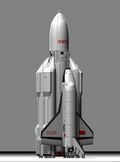Engineering:Ptichka
| Country | Soviet Union |
|---|---|
| Named after | Buria Ptichka |
| Status | 95-97% complete, property of Kazakhstan-Russia Joint Venture Company Aelita, at the Baikonur Cosmodrome, in the MZK Building.[1] |
| Days spent in space | None |
"Buria" (Russian: "Буря", "Storm" or "Tempest"), or "Ptichka" (Russian: "Птичка", "little bird"), officially known as 1.02 (GRAU index serial number 11F35 2K), is a nickname for the second Buran-class spaceplane, produced as part of the Soviet/Russian Buran programme.
Construction
Although Buria was closest to being completed of any of the Buran-class orbiters (after the orbiter Buran), it was never finished. The program was officially canceled in 1993, at which point the shuttle was 95-97% complete.
Projected flights
Orbiter 2K was preparing to its maiden flight to perform the first fully regular Buran-class orbiter operation (Orbiter 1K Buran in its flight was lacking regular thermal control and power systems). Buria also had to get remote manipulator and docking system. As on 1989, orbital flight test program for second orbiter was split into two missions, with space station approach test on the second, but delays in preparations changed the plans to perform all test tasks in one maiden flight, scheduled on to December 1991.[2] Mission profile included:
- unmanned launch
- automatic docking with Mir's Kristall module.
- crew transfer from Mir to the spaceplane, with onboard systems testing in course of twenty-four hours.
- remote manipulator testing
- undocking and autonomous flight in orbit
- Manned Soyuz TM No.101 docking to the orbiter.
- crew transfer from the Soyuz to the spaceplane and on board work in the course of twenty-four hours
- automatic undocking and landing
After program cancellation
Orbiter 1.02 was put on storage into MZK building (Russian: МЗК, Монтажно-Заправочный Комплекс, Assembling and Fueling Facility.) at Baikonur Cosmodrome, together with its full size test article OK-MT. Location: [ ⚑ ] 45°56′25.6″N 63°19′6.3″E / 45.940444°N 63.318417°E.
Current status
1.02 is believed to be the property of Kazakhstan-Russia Joint Venture Company Aelita, a subsidiary of RKK Energia, but there is no reliable information nowadays.[1]
See also
- Mikoyan-Gurevich MiG-105 — Soviet orbital spaceplane
- Space Shuttle Columbia
- Spaceplane
- Spacecraft
References
- ↑ 1.0 1.1 "Несостоявшаяся гордость отечественной космонавтики - второй летный корабль 11Ф35 первой серии (изделие 1.02)" (in ru). http://www.buran.ru/htm/1-02.htm.
- ↑ "Экипажи "Бурана" Несбывшиеся планы.". buran.ru. http://www.buran.ru/htm/pilots.htm. Retrieved 5 August 2006.
External links



